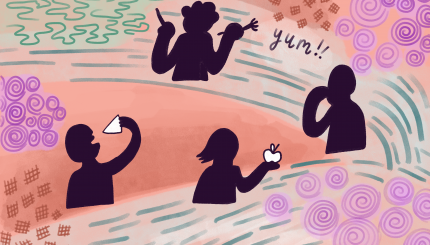Unless we’re at the gym or get sick or injured, we don’t often pay attention to our bodies. Yet without them, we couldn’t do anything at all. And not only physical things. Even our emotions and thoughts are experienced through our bodies. The simple truth is that while we are alive, consciousness is experienced only because we live in physical bodies that mediate our relationship to the ever-changing stimuli both inside and around us.
All of Jewish life and practice is a response to the fact that we are spiritual beings housed for a limited time in physical bodies. As early as the Bible, Jewish wisdom understood that spirit and body were distinct but inseparable. The Hebrew word for soul, nefesh, literally means a soul in a body — a living being whose flesh and spirit are integrated utterly. The first time this word occurs in the Bible is in Genesis 2:7, when God breathes nishmat hayyim, the breath of life, into Adam and renders him a nefesh hayyah, a living being.
There is another word in this verse, nishmat, which is a grammatical form of the word neshamah. By rabbinic times, neshamah was understood to refer to soul as well as breath. The soul-breath is what animates the embodied soul — or, the neshamah animates the nefesh. We would literally not be ourselves were we not breathing from moment to moment.
While Judaism tends to privilege the intellectual dimensions of our experience over the physical, Jewish spiritual practice can help us train ourselves to live each moment with greater attention to what is happening in our bodies, and in this way become more present to our lives. Drawing our awareness into our sensory aliveness can help us begin to heal from pizzur hanefesh, a scattered mind-state that is not grounded in the body.
With your help, My Jewish Learning can provide endless opportunities for learning, connection and discovery.
This practice is known as avodah b’gashmiut (literally “worship through corporeality”), a term from Hasidic spirituality that refers to the awakening of spiritual life through somatic experience. Avodah traditionally referred to religious actions like prayer or the performance of mitzvot, but the Hasidic masters expanded it to include actions such as eating, dancing or sex. Through prayerful dedication, the practice of avodah b’gashmiut can integrate the spiritual and physical domains into one whole.
Today, we can draw upon these antecedents to help us with our own avodah b’gashmiut. In any moment, we can choose to bring awareness to physical activities in order to cultivate a relationship with the divinity flowing through us.
This can begin immediately upon awakening in the morning. When you arise, pause to notice what is working. Feel your feet on the ground and your skeleton stretching long. This simple act, which many of us take for granted, is what we give thanks for in the morning blessing that blesses God as the zokeif kefufim, the one who enables the bent to rise. Pausing to notice the miracle of embodiment elevates this simple, often-taken-for-granted experience to one of mindful awareness of the spiritual underpinnings enabling our bodies to function.
Or consider the act of walking, something those of us blessed with the capacity to walk do all the time, mostly habitually and without thinking. Try seeing each step is an opportunity to wake up to the blessing of being alive. Let your intention rest in your feet and bodily sensations as you move. See how much awareness you can put into your toes, arches, balls and heels. Place your feet with loving intention. As the Vietnamese Buddhist teacher Thich Nhat Hanh instructs, “Walk as if you are kissing the Earth with your feet.”
This practice can even be used to foster awareness of the body’s autonomic functions, the processes of digestion and elimination performed by our bodily organs. The Hebrew blessing Asher Yatzar, traditionally recited after one uses the bathroom, brings awareness to these processes and leads us to pay attention to the miraculous wisdom inherent in our bodies.
Rabbi Zalman Shachter-Shalomi taught an embodied way to recite this blessing by bringing our attention inwards and visualizing the muscles in the belly. First, breathe into a relaxed belly. Then squeeze your innards towards your spine, feeling strength in the core of your body. Repeat this a few times. The body’s capacity to squeeze and release enables it to move waste through and out of the body. By bringing awareness to the workings of your innards and feeling your body at work deep inside you can cultivate sacred worship.
Any physical experience can be transformed in this way merely by bringing attention more deeply to the present moment. By simply harnessing our attention we can transform everyday habituated activities into opportunities to recognize the breath of life that makes each unique moment possible. These practices also help to quiet the thinking mind and bring awareness to the physical sensations, cultivating harmony between body and spirit and transforming physical actions into expressions of embodied spirituality. We can also open spiritual portals within us by listening to the inherent wisdom of our somatic selves.
Many people now practice yoga, either for physical fitness or spiritual growth. While practicing yoga postures, try listening deeply to the body’s subtle capacities for stretching open and to where and how you feel strength, flexibility, stiffness, softness, openness and constriction. Observe yourself in the postures, noticing where you feel discomfort or feel yourself approaching the edge of flexibility. Do you pull away quickly or soften into it and breathe? Do you get irritated or angry? Do you start thinking about other things to distract yourself from the discomfort?
All these are common responses to physical discomfort, but they are also common resistances many people encounter in their spiritual practices. Physical activities like yoga can help us learn about ourselves and how we show up to life’s challenges and opportunities. Working through the body to discover how we engage that which we cannot control is a profound way to go deeper into the spiritual journey. We may think that we are open and caring, but our bodies may show us to be harsh and judgmental when a particular posture becomes difficult. These discoveries present opportunities for profound spiritual growth. Over time, our attitudes and habits can be transformed alongside any physical shifts.
Ultimately, engaging in spiritual practice through our bodies is a way of living Jewishly with an awareness that every aspect of our aliveness is connected with the sacred. Embodied spiritual practice is not just something we “do” — it’s what we are. This awareness can help us attune more deeply to all that our bodies can do and help us thrive as we actualize our physical capacities. It can also serve as preparation for those times when our bodies are sick or injured, or as we experience the physical diminishment that comes with age.
As we strengthen our capacity to reside mindfully in our bodies through avodah b’gashmiut, we are growing spiritual muscle that can lift us up until our very last breath.
Want more? MJL’s “Discovering Jewish Spirituality” email series will guide you through authentic Jewish methods of bringing spirituality into your everyday experience. Sign up here.
Enhance your spirituality journey by joining our weekly Jewish Meditation Moment for a brief Jewish teaching followed by a guided meditation.



